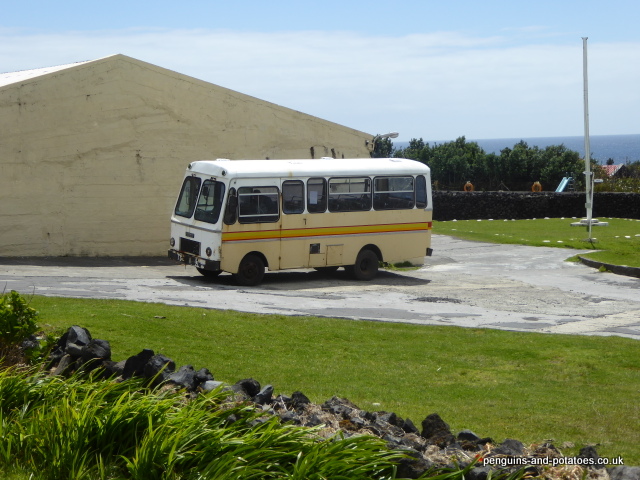Foot transport has always been the mainstay of transport on Tristan. In particular, there are not many routes for getting up on to the Base (the high ground at the top of the coastal escarpment, which runs from around 2,000 feet to the Peak at 6,760 feet) and the routes that there are can be quite hazardous. In some cases ropes have been tied to the rocks to help the climber. In all cases motor transport, even a trials bike, is out of the question to access these upland areas.
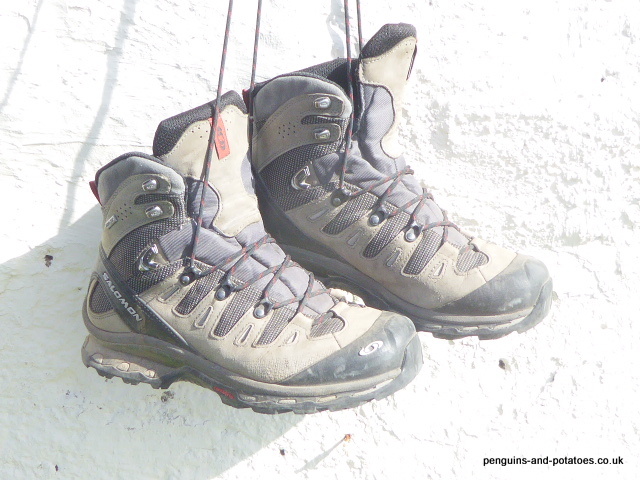
What is remarkable is the frequency that young islanders journey up onto the Base, often taking up fencing materials on their backs or bringing down a sheep carcass. In the age range of 15 to 45, a very large proportion of island men travel up to the Base as a matter of course.
In days gone by, seemingly, men often walked over to Sandy Beach, largely because it was possible to grow things there that would have been impossible on the Settlement Plain. This meant a climb to 2,000 feet, a traverse of about 6 miles along really difficult terrain, and a descent of 2,000 feet – then the return journey at the end of the working day!
Today, there is one interesting element to the amount of walking that we all have to do, which is to do with the abrasive nature of the volcanic grit that we walk on, and that is often used as a component of the concrete roads. In less than a year, I have almost worn away the soles of a pair of high-quality walking boots!
When sea conditions permitted, the journey to places around the coast was much easier by longboat. These boats were all made on the island. They were propelled by oar and by lug sail, and they became the normal means of transport from the Settlement, for example taking expeditions to Nightingale to collect penguin eggs (and the Little Petrel that is taken for meat), and to sail out to passing ships to barter local produce of meat, potatoes and woollen goods in exchange for fresh fruit and a wide range of other goods. These longboats were very seaworthy, but they were often handled in quite treacherous conditions, and disasters and loss of life were not unknown. It is about 15 years since the last longboat put to sea.
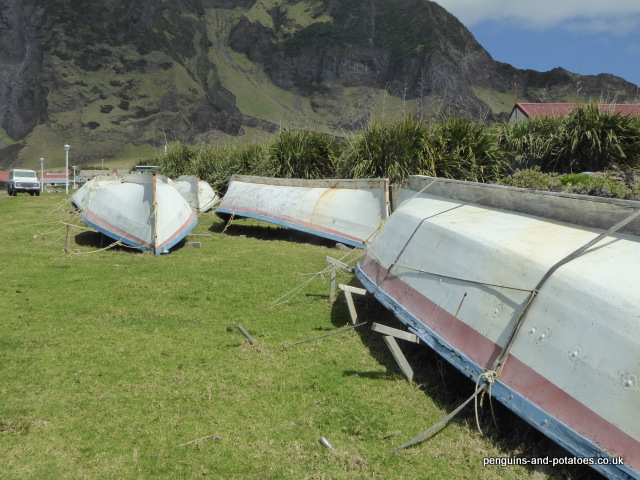
From the Settlement to the Potato Patches is a distance of about 2 ½ miles. For over a hundred and fifty years donkeys and ox-carts were used for this journey, taking humans, tools and materials out and bringing crops back. Gradually these sustainable means of transport died out. There are now just 11 donkeys remaining, living a life of retirement among the cattle on the settlement plain. These donkeys are not a breeding herd – all the males have been castrated – and in a sense it could be argued that they take feed from the cattle, they serve no purpose, and that they should be put down. Indeed this has been discussed from time to time, over the years. It says something for the traditional and kind-hearted nature of the Tristan islanders that they always come up with the sentiment of “Let the donkeys be to enjoy their retirement”.
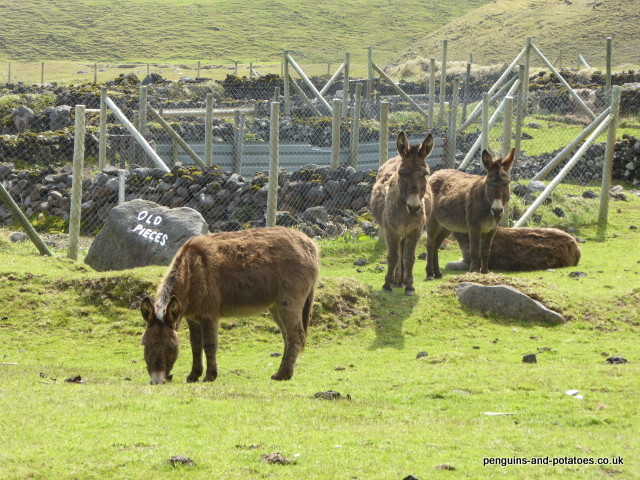
The evolution of transport on the island went from donkeys and ox carts to small tractors and trailers. Surprisingly, I have been able to find no evidence for ‘the little grey Fergie’ (TE20) being on Tristan, but most certainly the successors to the TE20, known as the MF 35 and then the MF 135, were used as work-horses for transport on the island, particularly for shared communal transport to and from the Potato Patches. These tractors, dating from the 1960’s, are still to be found, and are still working. Indeed, until ten days ago the only working tractor owned by the Agriculture Department was a MF135 – to our great relief we have now taken delivery of a larger 4WD MF268, which will make the world of difference to the productivity of the Department. Other Departments also have tractors for general light haulage duties, and it is a great tribute to the design and construction of the little tractors from the 1960’s that any of them are still running at all. None of them are fully functional, with the hydraulic systems and controls being the most frequent casualties.
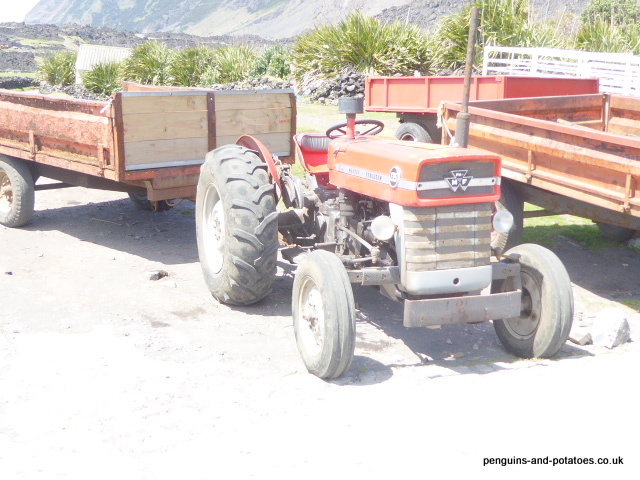
Individually-owned transport was the natural successor to the community-owned tractors. There is always the temptation for private buyers to import cheap second-hand vehicles, which are almost by definition approaching the end of their serviceable lives. As a result, there are several ‘dead’ vehicles around the settlement, vehicles that by any standards are beyond the end of their lives. This raises a question, which is “Is there any form of MOT test for vehicles on the island?”. The answer is “Yes”! No-one would pretend that the MOT test on Tristan is in any way similar to the MOT test in the outside world. But it does test and insist upon the main safety elements that are of relevance to driving on Tristan.
The vast majority of privately owned vehicles on the island are what could be called heavy four-wheel-drive vehicles, including all the main UK and Japanese makes. There are many Land Rover Defenders, as well as Discoveries, Range Rovers and Freelanders. Unfortunately, Defenders are well-known for rusting, and because of the salt-laden air rust is a serious problem on the island for all vehicles. It makes me glad that I had my own Defender undersealed, to better withstand the inclement weather in Scotland! In total, there are now over 50 heavy vehicles on Tristan, mainly heavy four-wheel-drive models.
Most families that own a 4WD vehicle also own a motorbike. This makes very good sense, because there are many functions for which a motorbike could be thought of as being perfect, whereas a 4WD would be overkill for some journeys. There is a size limit of 250cc for motorbikes, which is quite big enough for the essential needs of personal transport. There are some 50 motorbikes on the island. In general the bikes are ridden in a very moderate and responsible way, and one of my more remarkable observations is that I have never seen a motorbike or scooter being ridden without the rider (and passenger) wearing a crash helmet. I myself have just taken delivery of my own motorbike, so at last I can get around the farming areas that I need to see on a regular basis.
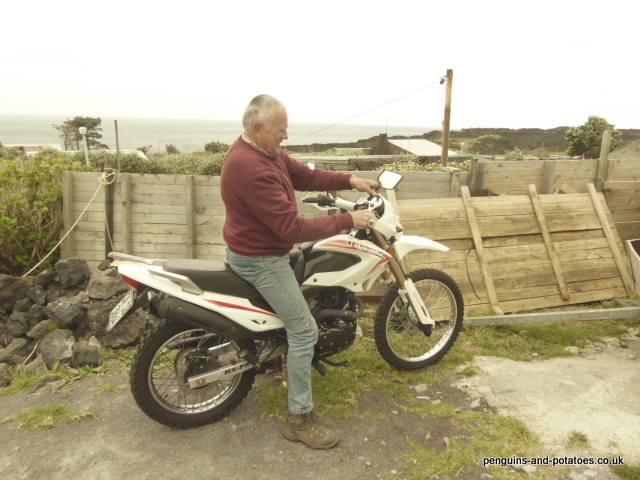
No article on transport on Tristan would be complete without mention of the occasional use of a helicopter on the island. We have an annual visit from the South African vessel SA Agulhas 2, which carries a helicopter, and there is the occasional visit of a Royal Navy boat also with a helicopter on board. When visibility conditions permit, some flying time is sometimes made available to the island, and it is a great relief for the islanders to have fencing materials transported up to the Base to save their back-breaking and knee-wrecking journeys carrying up these heavy loads. I hope to follow up with more details of the visits of the Agulhas in later articles.
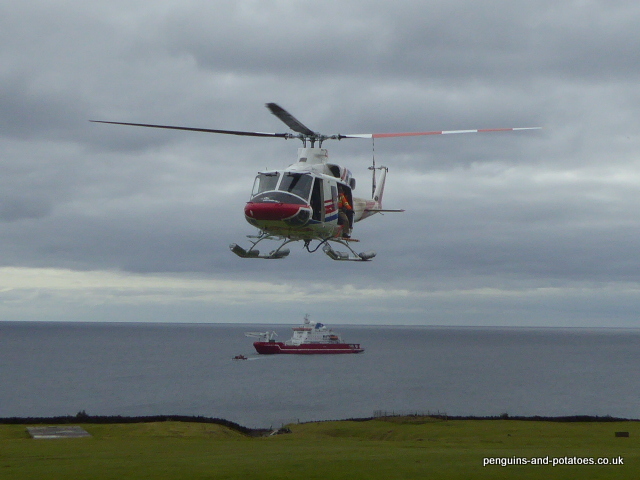
There is no perfect solution to the island’s transport problems. The longest one-way journey is around three miles, and fuel is expensive in relation to the very low wages. But people do have a need to get ‘out West’, to look after their sheep and cattle and, particularly, to tend their potato patches. There is a bus service that makes several journeys to the Patches every day, but this is largely patronised by the pensioners. For many people, their busy lives dictate the need for their own vehicle, so that they can come and go when they please.
